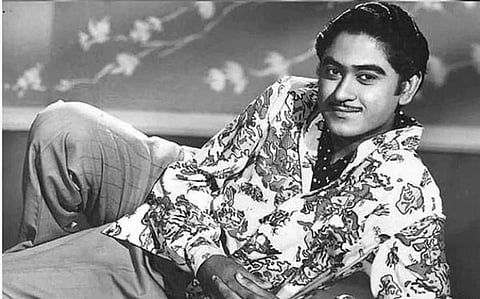

It’s a big book, literally and otherwise. Perhaps the first, if not the ultimate, biography of the revered
singer Kishore Kumar. The authors admit it themselves–– the subject is one that will spawn more books.
The result of deep research, this could well be the take-off point for future bios on Kishore, as it painstakingly puts down every milestone in his career, the ups and downs, including his idiosyncrasies, mannerisms and, to an extent, relationships.
Chronologically, we learn about the actor-singer’s antecedents, his siblings, and the turbulent relationship with his actor-brother Ashok Kumar. We discover the shy youngster, given to sitting under trees, and the start of his abiding love for Khandwa in Madhya Pradesh.
Detours are taken in the narrative to trace Ashok’s career starting with Bombay Talkies and subsequent move to Filmistan studio, as much to establish his influence in helping his brother later as to give us a glimpse of film history.
Valuable are some of the insights into a young Kishore’s nature, including his early forays into mimicry and his well-known imitations of his mentor, KL Saigal. His tomfoolery in the classroom, where he would beat a rhythm on his desk, singing nonsense rhymes like bam chik bam chik bam, are intimations of the man who would ad-lib during recordings, adding zest to his songs.
A little-known fact that Kishore lent his voice as part of a female chorus in 1936 is also brought to light. Early friendships with people like Shakti Samanta and Satyajit Ray explain the close bonding that would continue professionally.
Other gems pepper the book. We learn about Manna Dey composing for Tamasha to complete the work of composer Khemchand Prakash, who passed away suddenly, and that it was while shooting for the film, that, according to Filmfare, Kishore and Ruma fell in love. It comes as a surprise that the singer, a reluctant actor at best, was one of the highest-rated actors, working shifts through the day, letting other voices sing for him.
The schedule would tax him sorely, and strain his marriage to breaking point. As would his chauvinist belief that his talented wife should only tend his home.
The contribution of music directors like SD Burman in exploring and emphasising Kishore’s voice and ability to add emotion to songs tinged with sadness is elaborated in detail. And we watch the singer go through high phases and low, despite delivering hits, till Pyar ka Mausam and Aradhana give his career a sharp upward curve.
To the authors’ credit, the book does much to dissipate rumour, sifting gossip from reality. Thus, we learn that Rafi and Kishore were indeed close friends and the odious comparisons by their fan-camps are just chaffed flying from the rumour mill. Again the stories about Kishore neglecting a sick and irritable Madhubala are far from the truth that had him solicitous and caring till her dying day.
The authors share their insights into music when they point out examples of how Kishore blended voices to suit actors or scenes. An example is a contrast between the songs, Main Doob Jata Hoon and Pal Pal Dil ke Paas, the one sung to sound “deliberately shallow” as the character’s feelings were insincere, the other “mellow” and an “example of near-perfect playback singing”.
We learn of him working on a lower bass to suit an up-and-coming Amitabh Bachchan’s voice. Solely missing, however, is an analysis of his singing vis-a-vis his contemporaries, Rafi, Mukesh, Hemant Kumar and Manna De, each of whom was claiming his own place as a legendary singer.
Chapters on films like Chalti Ka Naam Gaadi, Door Gagan Ki Chhaon Mein, Door Ka Raahi are delightful, telling us much of what lay behind the scenes. Though comprehensive, too much research and information hamper readability and the narrative flow. The authors also intersperse their opinions and snatch us away from the milieu created to look into a microscope being trained on the genius.
In their ardour to state alternate views of events, the authors give the book the feel of a thesis rather than a happy read. Perhaps a stricter editor, who could have tightened the narrative, would have created a gem, taking away phrases like ‘churning out’, and ‘fiddler’ which have derogatory connotations, and the strange phrase, ‘friendly little critter’, definitely has no place in this book.
Yet, it’s a book worth a place on the shelves for fans and for those who want to explore the singer’s craft further.